Mushroom & Quinoa Soup
As I’ve said before, I don’t plan in advance the recipes I’m going to post here on the blog. I like to be inspired by the seasonal ingredients I buy every week and just create something with them. This week I’ve brought home lots of mushrooms and nettles, so the idea was to post a recipe here that highlighted one of these ingredients (I’m not quite sure if mushrooms and nettles go well together, hence why I didn’t attempt to put both in the same dish – probably a wise decision).
When I cook with mushrooms I like to keep things very simple. I usually just panfry them with lots of garlic and that’s it. However, I kept thinking about a delicious mushroom soup that I’ve made once, following this recipe, and because it’s still incredibly cold around here, I was craving something similar.
My original plan was to use millet in the soup, but I’ve found in the pantry a bag of quinoa 2 days past expiration date (ups) and used it instead. I was lucky enough to find the mushrooms I’ve used in this soup for a very good price, but I don’t want you to spend a fortune on these guys, so feel free to substitute the shiitake and pleurotus for creminis if you like. Also, you can definitely use millet in place of the quinoa, or even brown rice (you’ll just have to adjust the cooking times and probably add a bit more stock than the amount suggested bellow).
Last but not the least: I still have those nettles in the fridge and I’m not sure what to do with them. Have any of you cooked with nettles before? What should I do with them? Suggestion board is open. Thanks in advance! : )
Mushroom & Quinoa Soup
serves 4
250 g / 1 large onion, finely chopped
3 garlic cloves, minced
1 Tablespoon olive oil
25-30 g / 1 big chunk fresh ginger, peeled and minced
6 grams dried porcini mushrooms, soaked in 1 cup hot water (do not discard the water)
140 g / 1 large portobello mushroom, chopped into medium sized chunks
105 g shiitake mushrooms, coarsely chopped
200 g pleurotus mushrooms, coarsely chopped
150 g / ¾ cup quinoa
4 cups low sodium vegetable stock
3 Tablespoons tamari sauce
2 Tablespoons lemon juice
salt and freshly ground black pepper to taste
In a large pan over medium heat, add the oil, onion, garlic and ginger. Cook for 3-4 minutes, or until the onion has softened.
In the meantime, heat a dry skillet over medium-high heat and, once hot, add the quinoa. Toast the quinoa, stirring often, for 3 minutes or until it’s fragrant and only slightly brown in color.
Add the rehydrated porcini followed by the portobello, shiitake and pleurotus mushrooms. Give the mixture a good stir and add the quinoa, followed by 1 cup of the porcini soaking water and 4 cups vegetable stock.
Bring the liquid to a boil and, once boiling, decrease the heat to low-medium and simmer for 15-20 minutes, or until the quinoa is cooked. Add the tamari sauce, stir, and have a taste. If it’s not salty enough to your liking, add salt (I had about ½ teaspoon).
Right before serving, add the lemon juice and freshly ground black pepper. Serve immediately garnished with chopped parsley and panfried tofu, if desired.
Green Monster Soup with Za’atar Toasted Sunflower Seeds
I love a good bowl of soup anytime of the year, but I tend to eat a lot more soup during the cold winter months. Usually people tend to think of soup as the kind of dish where they can throw in as many vegetables as they have lying around in the fridge. I tend to think the opposite actually, and like to take a “less is more” approach when it comes to soup making.
This soup in particular is made with three different greens (spinach, cabbage and turnip tops) and has sweet potatoes and a little amount of rolled oats in it to make it creamier and balance the greens’ natural bitterness. There’s also ginger for some heat, and a crunchy seed topping to keep things exciting. I usually make this soup using solely cabbage and chard, but I couldn’t find the latter this week on the market, so I just replaced it with spinach and turnip greens.
Turnip greens are very easy to find in Portugal, but my (little) travel experience tells me it’s not an ingredient that’s easily available in other parts of Europe. If you can’t find them, use chard instead. I’d just advise you against making this an all spinach soup – maybe it’s just me, but I find spinach a little bitter (specially the new Zealand variety, which is the one I’ve used here) and that’s why I like to pair it with another green partner. I want to thank all of you who visit this blog regularly and wish you a wonderful new year. I’ll be back soon. In the meantime, eat your soup! :)
Green Monster Soup with Za’atar Toasted Sunflower Seeds
serves 4
For the soup:
2 Tablespoons olive oil
230 g / 1 large thinly sliced onion
5 garlic cloves, minced
23 g fresh ginger, peeled and grated
240 g / 2 medium sweet potatoes, diced
225 g / half a medium sized cabbage, thinly sliced
25 g / ¼ cup rolled oats
5 cups water
225 grams spinach leaves
180 g turnip greens
¾ teaspoon salt
½ teaspoon freshly ground nutmeg
For the za’atar toasted sunflower seeds
55 g /1/3 cup sunflower seeds
1 teaspoon olive oil
1 teaspoon za’atar
extra olive oil, lemon juice and za’atar for serving
For the za’atar toasted sunflower seeds: In a small bowl, combine the sunflower seeds with the oil and za’atar. Transfer the seeds to a skillet over medium-high heat and toast until they’re golden and fragrant (about 5 minutes). Reserve.
For the soup: In a large pot over medium heat, add the oil, onion, garlic and ginger and cook for 10 minutes, or until the onion has softened. If the vegetables dry out during this time, add a few tablespoons of water to loosen things up.
Next add the diced sweet potatoes, cabbage, rolled oats and 5 cups of water. Bring the soup to a boil and, once boiling, decrease the heat to medium. Cover and cook for 10 minutes or until the vegetables are cooked through.
Finally add the spinach and turnip greens as well as the salt and freshly ground nutmeg. Cook for additional 5 minutes, or until the spinach and turnip greens have shrunk considerably.
Transfer the soup to the bowl of a food processor. Working in batches, puree the soup until it’s creamy and smooth. Serve with plenty of za’atar sunflower seeds on top, an extra dizzle of olive oil and a squeeze of lemon juice.
Red Lentil and Cabbage Soup with Parsley Pistou
I’m sorry for posting again another soup recipe, but my soup fever has yet to stop. I know that, instead of thinking about ingredient combinations to try for soups and their toppings, I should seriously be thinking about making a dessert of some kind and posting it up here (this blog hasn’t seen one in sight for a couple of months now). I’m planning on working on that this upcoming weekend though, but until then, let’s (continue to) talk soup, shall we?
I’ve been eating this soup as a meal in itself for supper the last couple of days. Thanks to the lentils, it’s quite filling and heartwarming. It’s also quite affordable and literally feeds a crowd. There are a couple specifics about it that I’d like to highlight though. The soup tastes delicious the moment it’s made but I think it improves after a day in the fridge – like most stews, the flavours have time to mingle and develop. It also thickens quite a bit after being refrigerated so, if reheating, feel free to add a couple tablespoons of water to thin it out a bit.
The parsley pistou was a last minute addition that contributes with sharpness and freshness to the whole thing. You could make it by blending the ingredients together in a food processor, but my picky self thinks that chopping them by hand makes it more textured and encourages some flavours to be more prominent than others with each bite, instead of getting lost in an homogenized mixture. Enjoy the soup and see you soon! ;)
Red Lentil and Cabbage Soup with Parsley Pistou
(serves 6)
For the soup:
220g / 2 medium sized yellow onions, cut into half-moons
8 garlic cloves, finely chopped
2 tablespoons olive oil
300 g / 1 ½ cups red lentils, picked through
6 cups water or low sodium vegetable stock
400 g / 1 small head of cabbage, cut into thin strips (I used savoy)
¾ teaspoon salt (you might need less if using stock instead of water)
1 teaspoon freshly milled black pepper
For the parsley pistou:
35 g / 1 large bunch parsley
10 pitted green olives
1 garlic clove, minced
2 tablespoons lemon juice
7 tablespoons olive oil
For the soup: In a large pot over medium heat, add the olive oil, onions and garlic cloves. Sautée for 4 to 5 minutes, or until the onion has softened.
Add the lentils and the water or stock. Bring the mixture to a boil and, once boiling, decrease the heat to low medium. Simmer for 20 minutes.
Working in batches (or transferring the soup to a large bowl and using a hand blender instead) purée the soup in a blender until smooth. Return the soup to the pot, add the salt and black pepper and bring it to a boil. Add the shredded cabbage, reduce the heat to low and simmer for additional 15 minutes, or until the cabbage is very tender. Serve the soup with lots of pistou (recipe follows) on top and an extra pinch of black pepper.
For the pistou: Using a sharp knife, chop the parsley very finely. Chop the olives and garlic as well, mixing it, little by little, with the parsley. Transfer the mixture to a bowl, add the lemon juice and olive oil and whisk everything together. Have a taste and adjust the seasoning if needed. Serve over the soup.
Roasted Carrot Soup with Garlic and Dukkah
I’m in a soup kick at the moment. Last week it was the butternut squash soup, the week before that the turnip-kale one and, finally, this week, the roasted carrot and garlic soup. Warm and smooth soup is hard to beat around this time of the year, particularly when you live in a part of the world that has been unlucky (and, apparently, will continue to be) with the weather for a couple of weeks now.
This soup in particular requires minimal effort to make and you probably already have all the ingredients in your pantry. All you have to do is to chop a few carrots (if using organic, like I did, you don’t even need to peel them), roast them until sweet and dark around the edges and blend them with a few cups of stock and water to make a perfect, velvety cream.
The dukkah is equally easy and straight-forward to make, adding texture and an extra layer of flavour to the soup. The recipe bellow makes way more than what you’ll actually need for this particular dish, so feel free to use it in other preparations as well. A few tried and tested ideas: as a crust to pan-fried tofu or tempeh, on top of a kale and avocado salad and blended into a roasted tomato sauce. I’m sure you can come up with more ideas on how to use it though; the possibilities are endless. Enjoy the soup and I’ll be coming back next week with another recipe for cold weather weeknight meals. 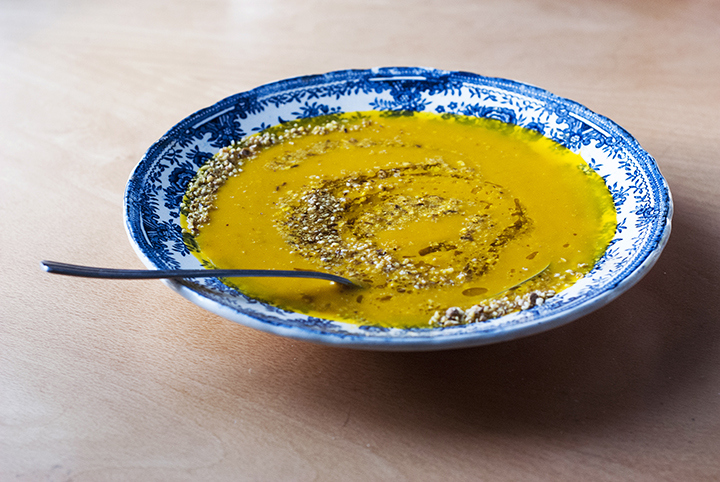
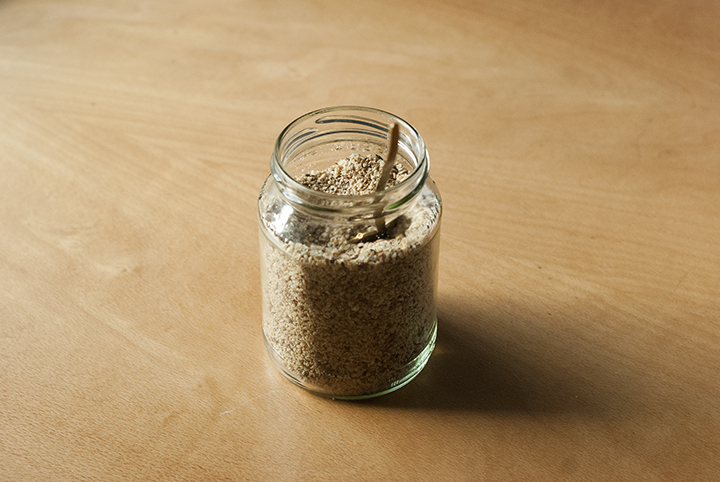
Roasted Carrot Soup with Garlic and Dukkah
(serves 4 to 6)
900 g / 11 medium sized carrots, coarsely chopped
1 Tablespoon olive oil
¾ teaspoon salt
½ teaspoon cinnamon
45 g / 1 garlic head
625 ml / 2 1/2 cups water
625 ml / 2 ½ cups low sodium vegetable stock
For the dukkah:
48 g /1/3 cup hazelnuts
80 g / ½ cup sesame seeds
2 Tablespoons coriander seeds
1 Tablespoon cumin seeds
½ teaspoon salt
wedges of lemon juice, to serve
Pre heat the oven to 180 C. Line a large baking tray with parchment paper. Add the carrots, oil, salt and cinnamon to it.
Grab a piece of aluminium foil (15 by 15 centimetres is more than enough) and add a drizzle of olive oil over it. Place the garlic head, cut side down, over the foil and add a pinch or two of salt. Wrap the foil around the garlic head and put it in the oven, along with the carrots. Roast the vegetables for 45-60 minutes, or until the carrots are tender and golden brown.
In a pot over medium-high heat, heat the stock and the water until boiling point. Once boiling, decrease the heat to low and let it simmer until needed.
Add the carrots to the bowl of a high speed blender. Squeeze the roasted garlic cloves out of their skins and add them to the bowl as well. Add the water and stock and process until smooth (you might have to do this in batches, as a regular blender doesn’t hold such amount of food and liquid all at once). Have a taste and adjust the seasoning if needed.
In the meantime, put a large skillet over medium heat and, once hot, add the hazelnuts and toast them for 2 to 3 minutes or until golden brown. Place the hazelnuts into a clean kitchen towel and rub the towel to peel off their skins. Add the sesame, coriander and cumin seeds to the same skillet and toast until the spices smell fragrant and the sesame seeds have darkened just a bit.
Add the toasted nuts, seeds and salt to the bowl of a food processor and process until you have a sand-like mixture. Serve the dukkah over the soup along with a squeeze of lemon juice. The dukkah will keep, stored in a jar, for a couple of weeks.
My Take on Harira
When I was a kid (probably 6 or 7 years old) my parents took me on a road trip to the south of Spain. Eventually, after hours and hours of driving under a massive sunlight, we arrived at Gibraltar (which technically is a British territory). Since we were so close to the north of Africa, I proposed we could go to Morocco, something that unfortunately didn’t happen as the plan was to stay for about a week in Málaga.
Flash-forward to date and I have yet to go to Morocco. Until then, I will try to continue to bring Morocco to me by exploring its cuisine and making my own versions of dishes such as tagine and harira. The latter – a chickpea and lentil soup – is traditionally made with meat (which I obviously don’t consume) and, sometimes, rice and vermiccilli noodles. The soup is cooked for a long period of time – sometimes over an hour – and thickened up with a couple tablespoons of flour, almost verging on a hearty stew. It is a one pot meal, and what a delicious and filling one… I’ve been having Harira for dinner for the last couple of days and I can tell for sure it is the best lentil-based soup I have ever made. Its heart-warming nature makes it just the perfect meal for the few cold winter nights we still have ahead.
Harira
(serves 6 to 8)
½ cup / 95 g dried chickpeas, sorted, soaked overnight, rinsed and drained
1 cup / 215 g puy lentils
3 tablespoons olive oil
1 medium onion / 1 cup / 130 g finely chopped
3 garlic cloves, peeled and finely sliced
2 medium carrots / 1 cup / 130 g cut into small cubes
1 teaspoon ground cinnamon
2 teaspoons ground ginger
2 teaspoons cumin seeds, coarsely pounded in a mortar
½ teaspoon freshly ground black pepper
a pinch of red pepper flakes
1 can / 2 cups / 450 ml canned tomatoes, liquidized in a food processor
5 ½ cups water
1 ½ teaspoons sea salt
1 tablespoon cornstarch
2 lemons, quartered
1. In a large pot over medium heat add the oil, onion, garlic, carrots, cinnamon, ginger, crushed cumin seeds, pepper and pepper flakes. Sauté for 5 minutes or until the onion has softened. If the mixture seems dry and the spices start to stick to the pot, add up to ¼ cup of water to loosen things up a bit.
2. Add the liquidized canned tomatoes, chickpeas and 5 cups of water to the pot. Turn the heat up to medium-high and let the liquid come to a boil. Once the liquid is boiling, lower the heat to low, cover the pot with a lid and cook for 30 minutes.
3. After that time, add the puy lentils and cook, covered, for another 30 minutes.
4. In the meantime, in a small bowl, combine the cornstarch with ¼ cup of water. Stir well so that the cornstarch dissolves completely.
5. At the very last minute of cooking, add the salt as well as the cornstarch mixture to the soup. Give it a good stir with a wooden spoon (it will thicken up a bit thanks to the cornstarch), have a taste and adjust the seasoning. Serve in large bowls, adding a splash of lemon juice to each individual serving.
Chestnut and Mushroom Soup
A few days ago, I’ve come across a variety of chestnut soups both online and in some cookbooks. In most cases, the chestnuts were paired with mushrooms, but I’ve also spotted some soups which combined the former with cauliflower, parsnips, or even lentils (such as this one). I never thought of using this ingredient in a soup before, but it seemed perfectly logical to do that, as chestnuts, when puréed, are extremely velvety. So, hereby follows my version of a chestnut and mushroom soup, and all I can tell you is that, if you happen to make it and never tasted a chestnut soup before, you’ll be surprised by how good and delicate it is. The mushrooms add some depth, balancing the natural sweetness of the chestnuts, and the whole thing just tastes like autumn. I bet I will be making this again in the meantime, as chestnuts have now invaded the markets and are begging to being used in a whole range of preparations. They’re delicious by their own, simply roasted with coarse seal salt, but you can also enjoy them not only in soups and savoury dishes, but in sweet treats as well, such as puddings and pies (I’ve made a chestnut pie one of these days and thoroughly enjoyed it). Fall is definetely my favorite season, mostly because of its fresh produce, which I absolutely love – pumpkins and squashes, brussel sprouts, beetroots, apples, persimmons… – but also because of its cold, yet sunny, days.
Chestnut and Mushroom Soup
(Serves 4)
1 medium sized onion, finely chopped
olive oil
½ teaspoon fresh rosemary, minced
2 cups (175 g) cremini mushrooms, laminated
1 cup (190g) peeled roasted chestnuts (store bought is fine)*
3 ½ cups (875 ml) vegetable stock
fresh parsley, for garnish
1. In a pot over medium heat, add the onion, rosemary and one or two teaspoons of olive oil. Sauté until the onion has softened.
2. Add the mushrooms and the chestnuts to the pot and cook for 5 minutes, or until the mushrooms have released their juices.
3. At this point, add the stock and a pinch of salt and bring the soup to a boil. Decrease the heat to a low-medium and let the soup simmer for additional 5 minutes.
4. Transfer the soup to a blender and purée until it’s totally smooth and creamy. Have taste and add a little more salt if needed.
5. Serve immediately, garnished with a few parsley leaves.
*If you want to roast the chestnuts yourself, do the following: pre-heat the oven to 180ºC. Make a small incision with a knife into each individual chestnut. Put the chestnuts in a baking tray, sprinkle them with sea salt, and cook in the oven for about 30 minutes. Once the chestnuts are cooked, peel their skins – the peeling process is easier if the chestnuts are still warm.
Pea, Apple and Ginger Soup
When I was a kid, sundays were the days I used to dislike. I didn’t really adapt well to the kindergarten, and in the late afternoon of every sunday, I’d feel quite sad about the fact that Monday morning I had to go there. As a child, I was indeed a pretty unsocial human being: I didn’t speak much, and I’d most likely run away when other children would come to talk/play with me – fortunately, I’d overcome this extreme shyness as I was growing up, even though some of it has remained throughtout the years and I’m afraid to assume it still remains as part of my adult personality.
It might sound weird, but I do think my photographic obsession with still lifes has a lot to do with my childhood and those distressed sunday afternoons. Still lifes are always melancholic, quiet, and perhaps also a bit enigmatic. On the same hand, their classical concept involves the presence of food and some other elements (such as sheets of paper, hardcover books, feather pens, and so on) that, when combined together, almost always make for bucolic, serene scenes.
It’s also surprising that usually, in still lifes, food and writing tools are placed together. It’s as if the first couldn’t live with the latter. Food isn’t dissociated from writing, and that’s also the reason why I find, in the still life, the basis of food writing.
So today is Sunday, seven o’clock in this part of the world – unlike some years ago, there’s no drama involved as I don’t have to go to school tomorrow. My afternoon, as many of my sunday afternoons, was spent in the kitchen, making a big pot of pea soup and a couple other things to be enjoyed throughout the week. It’s not a traditional pea soup the one I’ve prepared today: sweet apples were used as well as a good amount of freshly grated ginger. The end result: you have sweetness from the peas and apples, freshness from a couple leaves of mint, and a light heat from the ginger. Both flavor and texture are well balanced – almost as every still life composition seems to so effortlessly be - contributing for a subtle, yet tasty, outcome.
Pea, Apple and Ginger Soup
(makes 4 servings)
1 large onion (180 grams), finely cut
2 tablespoons olive oil
¼ cup freshly grated ginger
2 medium-sized sweet apples, such as Starking and/or Red Delicious, peeled, cored, and cubed (about 230 grams)
400 grams frozen peas
1 teaspoon fleur de sel
4 cups (1 liter) light stock
1 small handful (10 grams) fresh mint, finely chopped, plus a few leaves, for garnishing
100 ml oat cream (optional)
1. In a large pot over medium heat, heat 2 tablespoons of olive oil. Add the onion and cook for 2 to 3 minutes, or until it starts to soften. Add the ginger, fleur de sel and apples and cook for additional 2 minutes.
2. Add the stock and bring to a boil. Once boiling, add the peas and let the mixture boil for 2 to 3 minutes, after which you should reduce the heat and let the soup simmer for 10 minutes, or until the peas and apples are cooked.
3. Remove the pot from the stove. Transfer the soup to a food processor (you can also use an hand blender) and process for 2 minutes or until the soup is creamy and totally smooth. Serve immediately, garnished with a few mint leaves and a couple tablespoons of oat cream, if desired.
Recipe remotely inspired by The Millenium Cookbook
Note: The still life pictures shown here were taken by me and are part of personal projects.
Roasted Butternut Squash and Red Lentil Soup with Cinnamon
I served this soup yesterday to some house guests who came over for dinner and got such great reviews that I thought sharing it with you. We were eight at the table yesterday night, meaning that I made a huge pot of soup and will be enjoying the leftovers today as part of my Christmas dinner. Red lentils and butternut squash really are a great combo, and the natural sweetness of the latter (enhanced by roasting) is complemented by the addition of cinnamon. To give things a little punch, dried chiles are added to the soup, and the final result - yet very delicate - has some background heat, almost like the role played by back vocals in melodies. A couple more technical notes on the soup: it lasts for a couple of days in the refrigerator (three to four), but as it has the tendency to thicken over the time, add a little water when reheating it. Also, if you don’t have the chiles at hand, you can add some cayenne pepper instead (1/4 teaspoon should be enough).
And finally last, but not the least: there are a couple of traditional portuguese recipes (both sweet and savory ones) typical for this of the year that I’d like to post up here. I still do have to work on them, as they’re not vegan, but once I get them right, they’re all yours too. Mery Christmas to all of you. Love, J.
Roasted Butternut Squash and Red Lentil Soup with Cinnamon
(for 8 to 10 servings)
1,3 kg butternut squash, seeded and cubed, but not peeled
1 and ½ cups (270 grams) red lentils
8 cups (2 liters) light vegetable broth
3/4 teaspoon plus 1 teaspoon ground cinnamon
1/2 teaspoon ground ginger
3 small dried red chiles, stemmed and finely cut
salt to taste
2 large white onions, finely chopped
olive oil
a handful chopped coriander, for serving
8 tablespoons pine nuts
1. Pre-heat the oven to 180ºC. Line a baking dish with parchment paper and lightly coat it with olive oil. Add the cubed butternut squash, sprinkle with a little salt, and roast for 30 to 40 minutes, or until the squash is tender and golden brown. Remove from the oven and let cool at room temperature.
2. In the meantime, heat a large pot over medium-heat, add a few glugs of olive oil (2 to 3 tablespoons), the chopped onion, dried chiles, 3/4 teaspoon of ground cinnamon, and the ground ginger. Cook, stirring often, for 8 to 10 minutes, or until the onion has softened and browned just a bit.
3. Add the lentils and stock to the pan. Bring to a boil and, once boiling, reduce the heat to a low-medium and simmer for 20 minutes, or until the lentils are cooked. Once the lentils are cooked, add the roasted butternut to the pot, and season with salt to taste.
4. With an immersion blender, puree the soup until smooth.
5. Toast the pine nuts in a large dry skillet over medium-high heat. It should take about 3 to 4 minutes to get them slightly brown. At the last minute of toasting, stir in 1 teaspoon of ground cinnamon and a pinch of salt, mixing well until the pine nuts are well coated.
6. To serve, transfer the soup to deep plates and add plenty of chopped coriander and one tablespoon per person of the toasted pine nuts.
recipe loosely inspired by Moro East
Ratatouille Soup
When it comes to food, I’m not a purist. That being said, I have no problems eating canned beans or store bought cookies, as long as they’re vegan and taste good (although, quite frankly, I often cook my beans and bake my cookies). I generally don’t have “prejudices” against canned stuff, and if there are canned produces I use on a regular basis, they are tomato sauce and roasted peppers. They’re vegan, taste good, and although it’s often said there’s nothing as homemade tomato sauce, I’m totally sold to the canned one.
When it comes to recipes, specially traditional and local ones, I’m also not a purist. I do believe moussaka is not the same without meat in it, but I do really enjoy my dairy-free version of the greek classic; the same goes for pizzas and lasagnas, foods that usually call for cheese, and that I most of the times make cheese-less. Actually, both vegans and vegetarians end up, most of the time, tweaking recipes to get them to fit their diets, and that often means to make a traditional dish the unconventional way. This whole process of tweaking recipes fascinates me, as that doesn’t mean they’ll loose their former character just because they’re made a little different by some vegans and vegetarians out there. For me, respecting the identity of a certain local recipe (I’m thinking of portuguese traditional foods by the way), doesn’t mean you have to make it exactly as people did a hundred years ago. Time has passed, dietary needs have changed thanks to our growing knowledge on nutrition and health issues; and I feel it’s by tweaking and experimenting with flavors, textures and so on, that you keep the spirit of traditional foods alive nowadays, more than sticking to the way they’re – traditionally speaking - supposed to be made.
I found myself thinking about all this because of today’s recipe. Ironically, a recipe inspired by a french dish that is already vegan. There is much debate on how to make traditional ratatouille, but I don’t really want to contribute to the discussion. My version of it calls for canned tomato sauce and canned roasted bell peppers, as it saves up some time, being therefore more user-friendly, but if you want to make everything from scratch, just go ahead. Also, by adding far more liquid than it’s usually added on a stew, I make more of a soup, rather than a side dish. This ratatouille soup, alongside with a good slice of toasted wholegrain bread, makes for an excellent comforting meal, perfect for the autumn days to come.
Ratatouille Soup
(serves 6)
300 grams aubergine
300 grams zucchini
3 medium size tomatos, coarsly chopped
2 roasted bell peppers, coarsly chopped
3 garlic cloves, minced
2 tablespoons olive oil
½ red chili pepper, finely cut
½ teaspoon dried thyme
½ teaspoon dried oregano
1 cup plain tomato sauce
½ cup red wine
1 1/2 cups light stock
1 bay leave
salt and pepper to taste
1. Start by preparing the aubergine and zucchini: slice both vegetables into 0,8 cm thick rounds, and then cut each round into 4 equal pieces. Set aside.
2. In a large pan over medium heat, add the olive oil, garlic, chili, dried thyme, oregano and bay leaf, and sautée for 2 minutes. Add the tomatos and roasted bell peppers and cook for 5 minutes, stirring occasionally.
3. Now, add the stock, red wine, and tomato sauce to the pan, and cook for 10 to 15 minutes, or until the tomatos start breaking down and you get the consistency of a thick, hearty sauce.
4. Discard the bay leaf. Transfer the pan to your counter or kitchen table, and with the help of an immersion blender, blend the mixture until smooth.
5. Return the pan back to the stove, add the zucchini and aubergine, and cook, over low-medium heat, for at least 25 minutes, maybe a bit a longer – the point here is to slightly overcook the vegetables. Add salt and pepper to taste.
6. Serve the soup hot or at room temperature – it’s particularly good alongside a slice of wholegrain bread - bearing in mind it will thicken in the hours to follow the end of the preparation.
Seasonal Minestrone
Surprisingly enough, yesterday - with an outside temperature of 35 degrees -, I found myself sneezing and coughing all the time. I knew I was about to get sick, and started craving a comforting soup and toasted bread, no matter how hot was outside and how sweaty I’d get right after eating those foods. I had some seasonal veggies sitting on the fridge that would make for a good pot of soup, and it didn’t take me long to get my hands at preparing them (peeling, slicing and all), although I must confess I was about to give up a few times during the process and go for a nap. I’m usually very determined when it comes to satisfy my cravings, and the idea that, in the end, I’d get a huge pot of soup that would make my lunches and dinners for the rest of the week, worked out as the main motivation factor.
I ended up following (although not stricktly) Jamie Oliver’s recipe for a Spring and Summer Minestrone, that I’ve bookmarked from his book Jamie Does. I adapted the recipe to fit what I had on hand, and I guess that’s the spirit of minestrone anyway – use whatever vegetables are in season and that would go well together for a hearty, filling soup. The original recipe for the pesto calls for Parmesan, but as I don’t do cheese, I’ve just ommited this ingredient and had not problems at all. Just bare in mind Parmeasan is quite salty, so use a good pinch of salt in the pesto to work as a substitute and to balance things out.
Seasonal Minestrone
(serves 6)
200 grams carrots
300 grams zucchini
3 garlic cloves
1 large leek
1 large tomato
a bunch of parsley
2 handfuls watercress
1 cup frozen peas
150 grams short pasta
1 small cabbage
2 liters good tasting stock
salt and pepper
olive oil
for the pesto:
a bunch of basil
60 grams pinenuts
3 tablespoons olive oil
2 small garlic cloves, peeled and thinly sliced
a pinch of salt
1. Start by preparing the carrots and zucchini: slice each vegetable into quarters, and then slice each quarter into cubes of aproximadetely 0,8 to 1 centimeter thick.
2. Then, thinly slice the leek and garlic cloves.
3. Heat your largest pan on medium heat, add a few glugs of olive oil, the leek, garlic, carrots and zucchini. Stir and cook for about 5 minutes.
4. Roughly chop the tomato, parsley, and watercress. Slice the cabbage into halves, remove the hard core, and finely shred each half. Add the veggies to the pan.
4. Now, add the peas, pour in the stock, and bring to a boil. Once boiling, add the pasta and salt and pepper to taste. Lower the heat to low-medium, and let the soup simmer for about 10 minutes, or until the pasta is cooked. Taste and adjust the seasonings if needed.
5. To make the pesto, add the basil, pinenuts, garlic cloves, a pinch of salt and the olive oil to a food processor, and pulse everything for 1 minute, or until the mixture starts coming together into a paste, but isn’t totally smooth. Have a taste and adjust the flavors (adding a bit more of one or another) if needed, bearing in mind you want to find a balance between all the ingredients.
6. Divide the soup among deep plates and top each serving with a good tablespoon of pesto. Drizzle over a little olive oil and add some fresh basil leaves.
recipe inspired by Jamie Does, published by Penguin Books
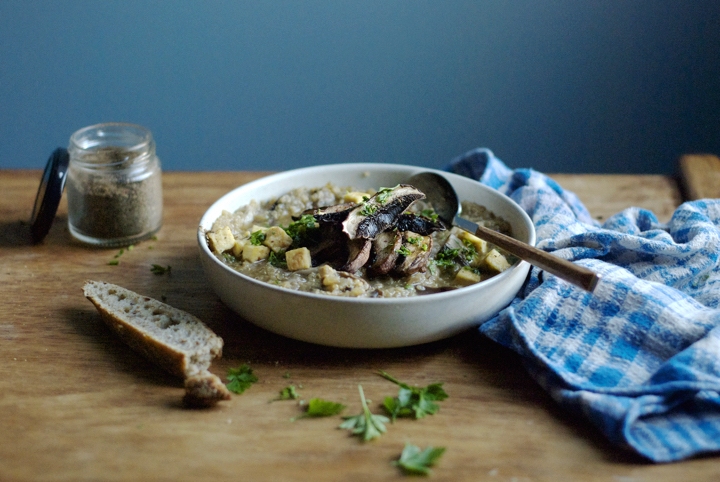
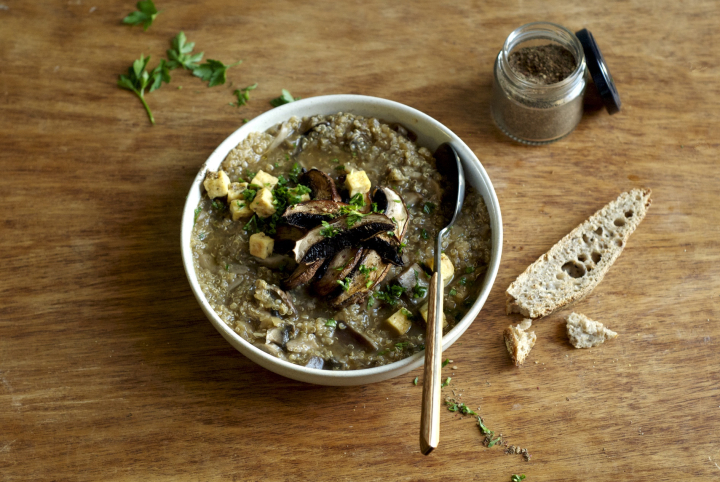
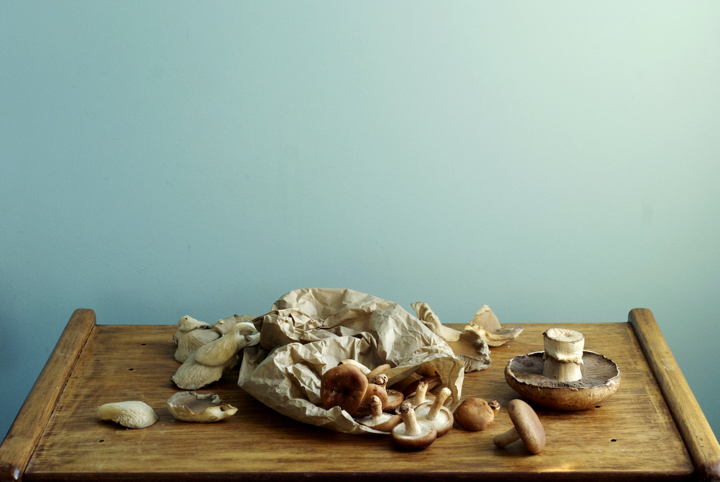
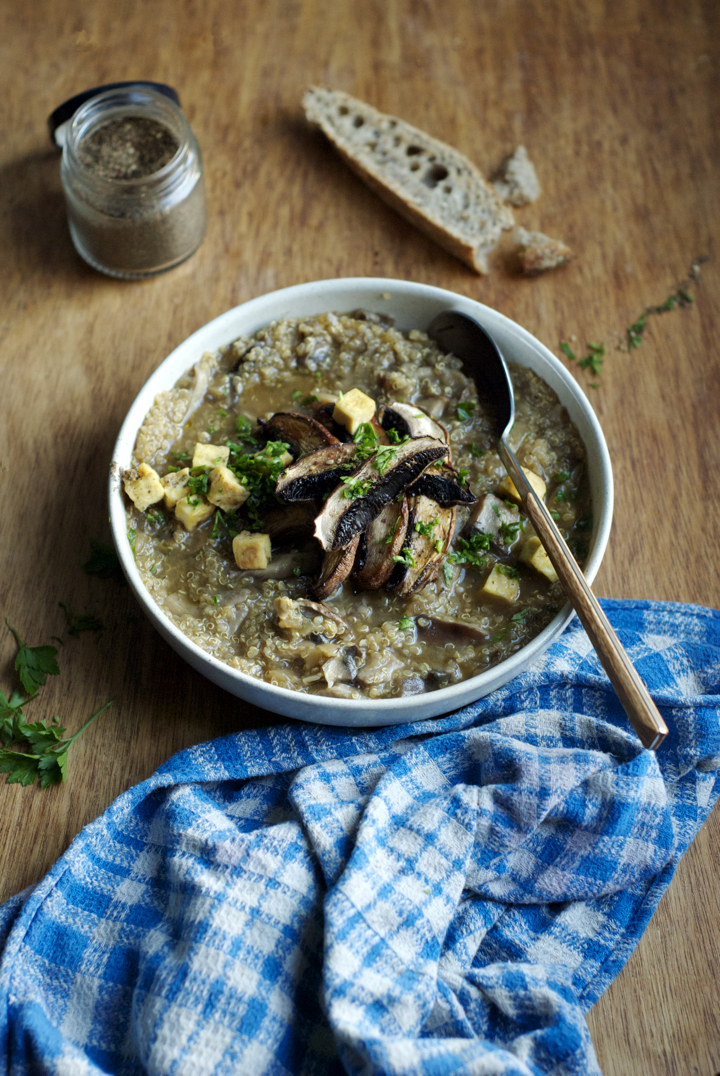
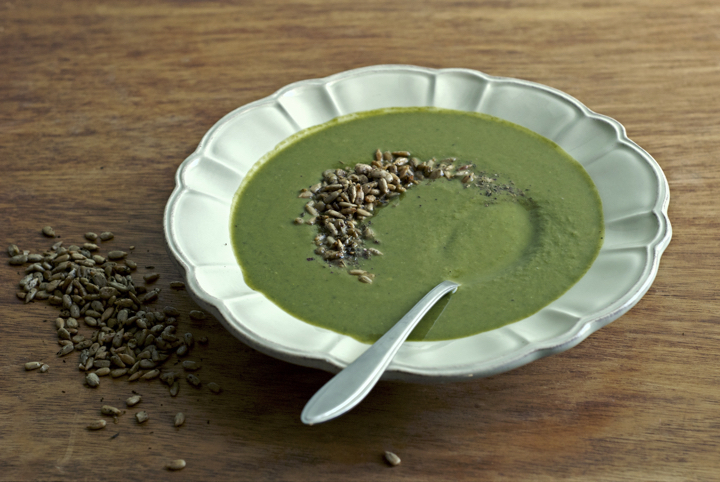
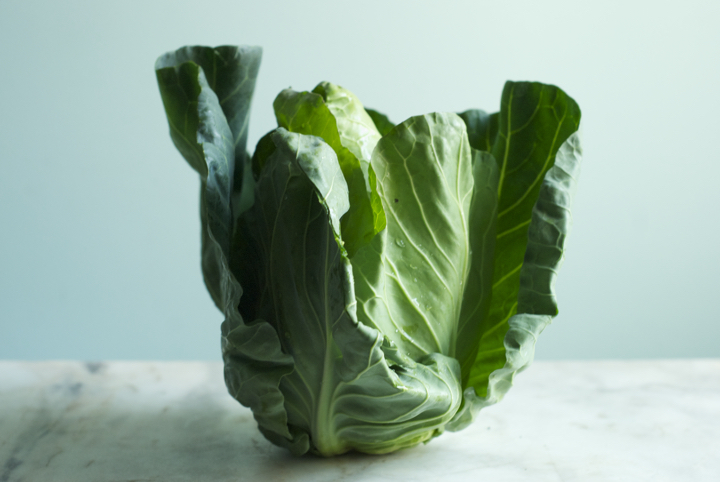
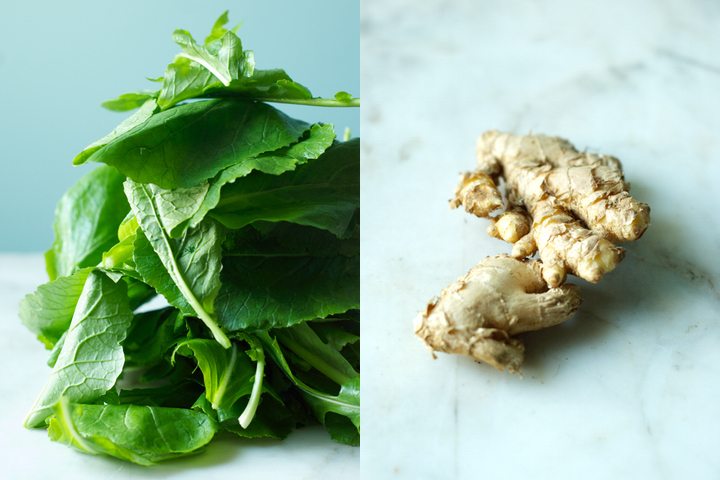
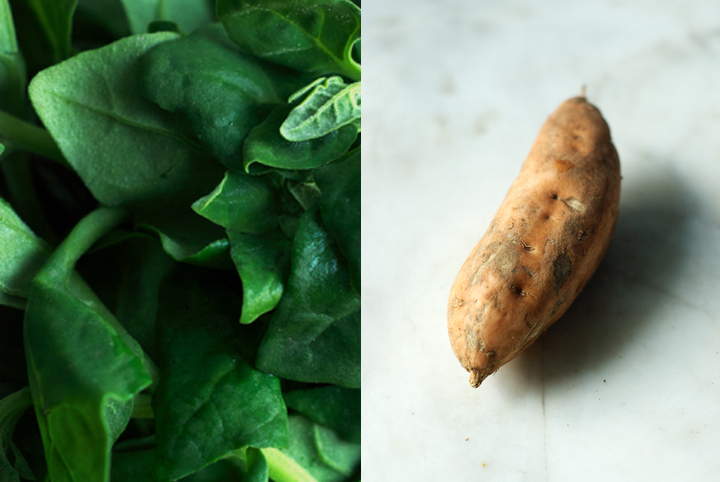
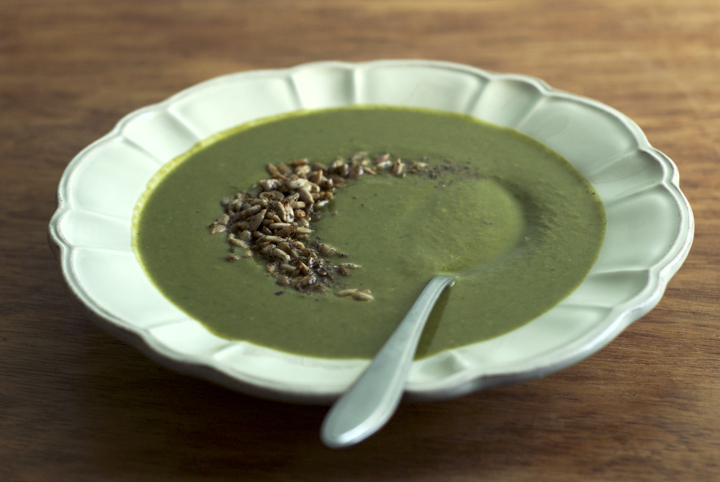
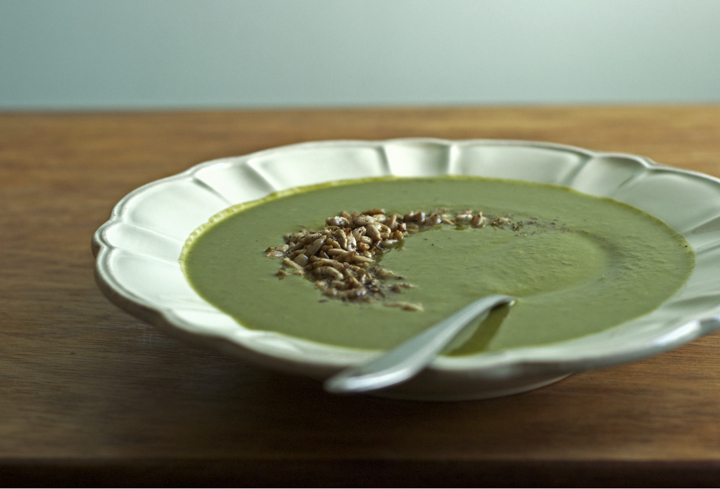
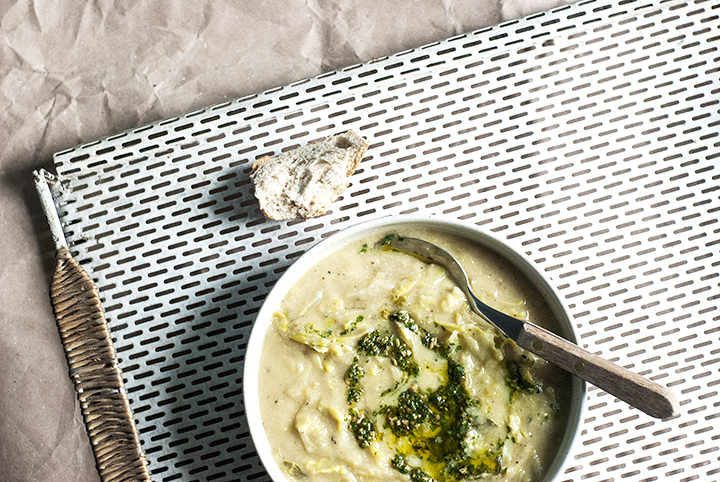
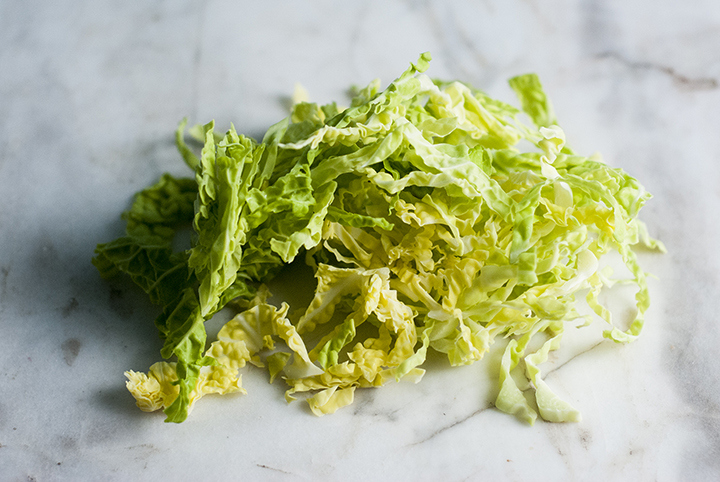

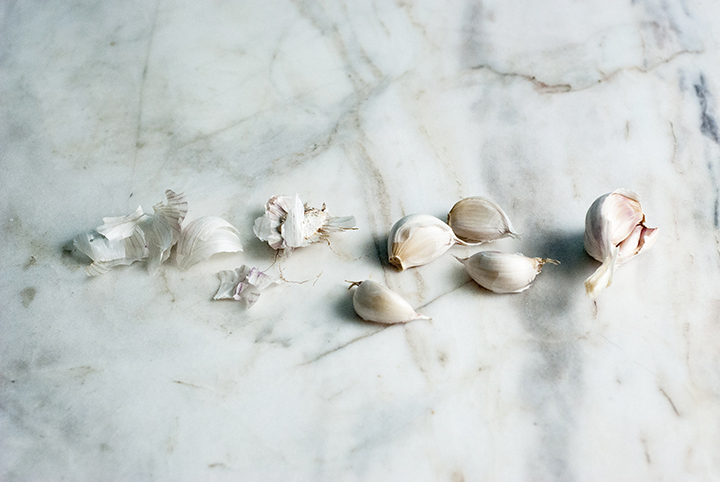
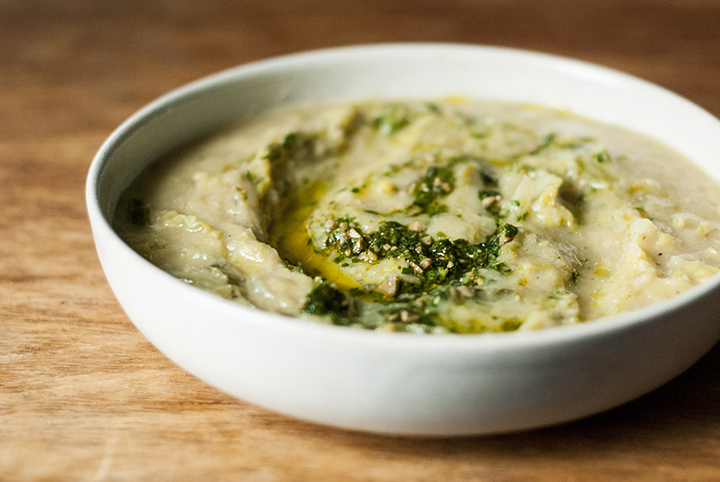
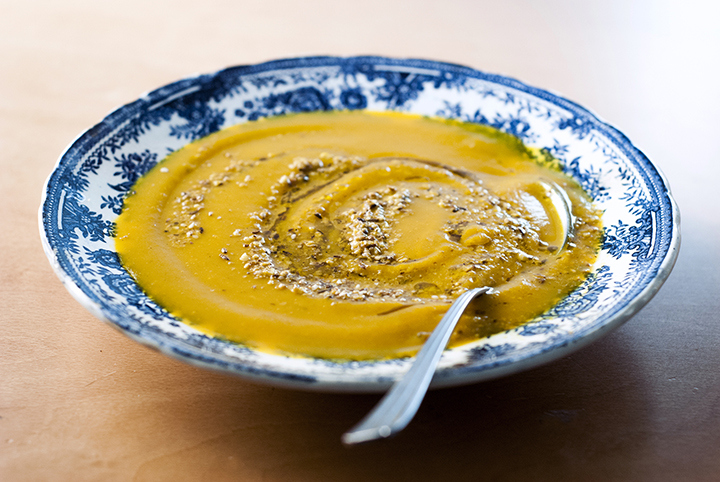
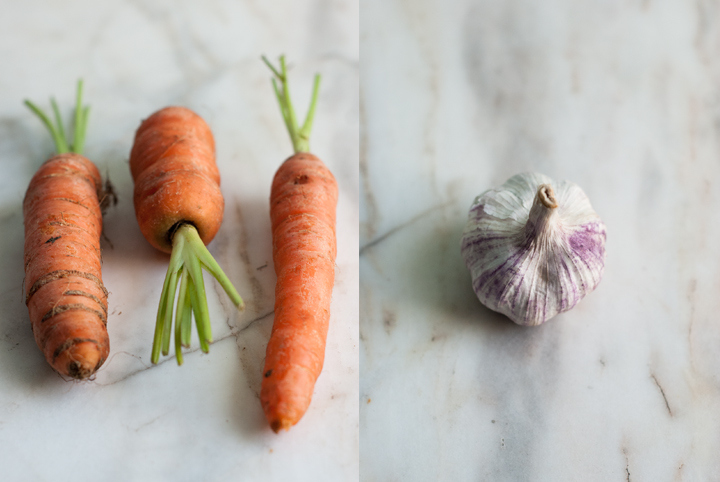
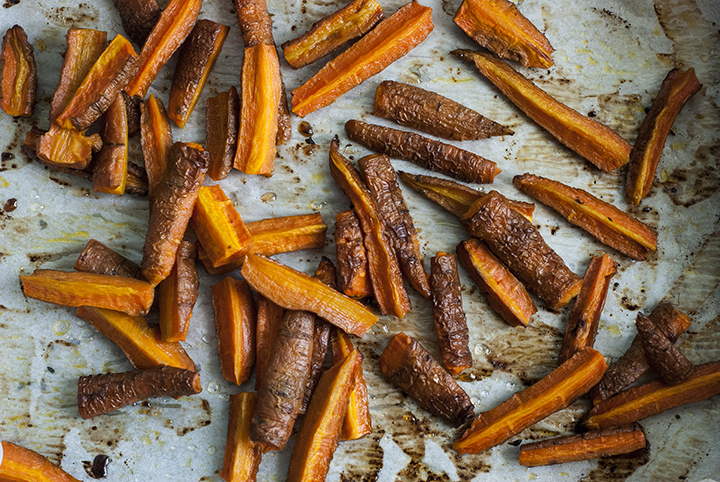
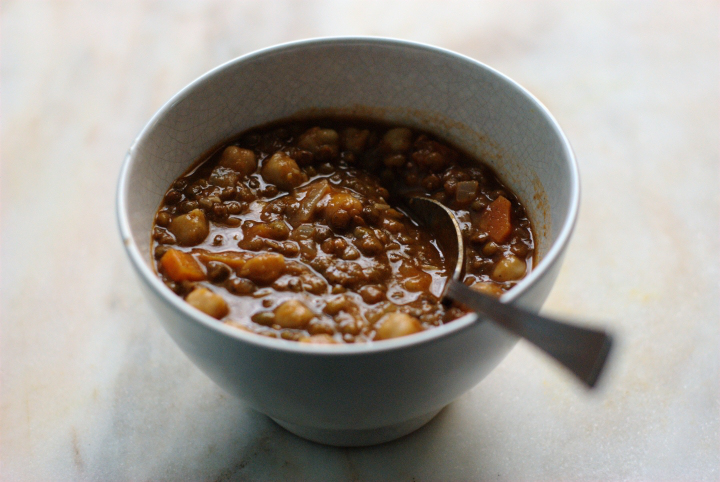
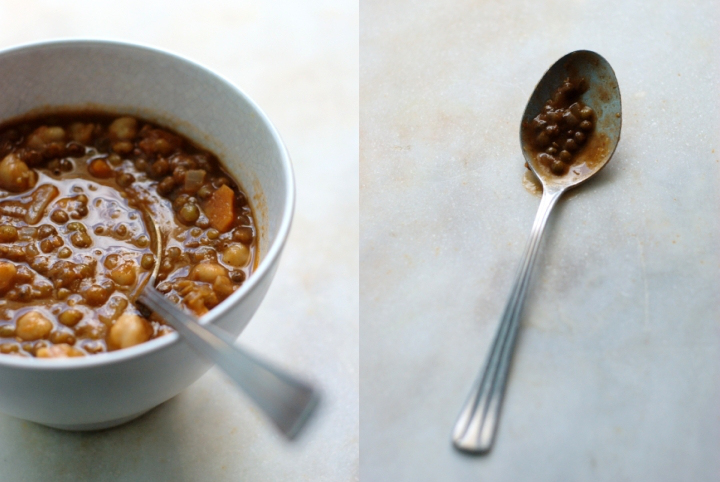
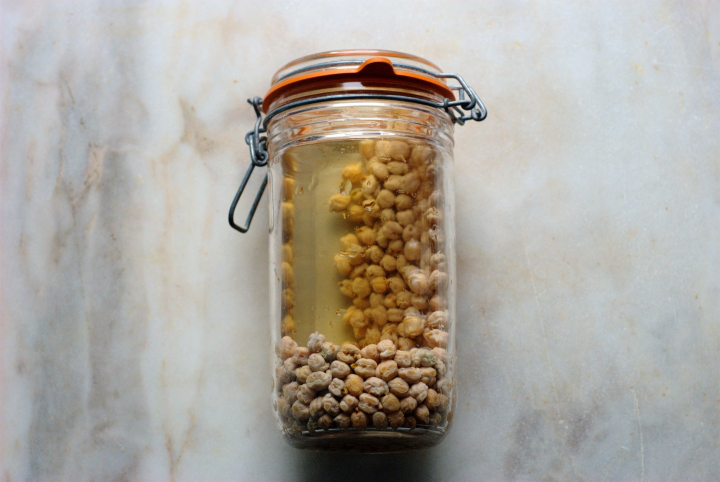


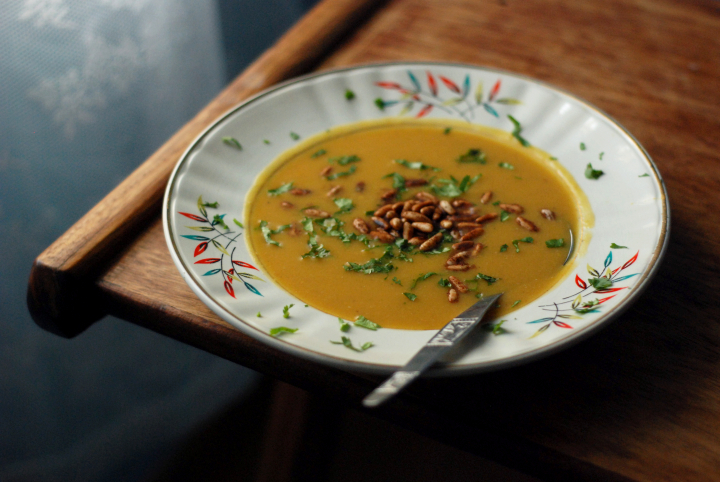
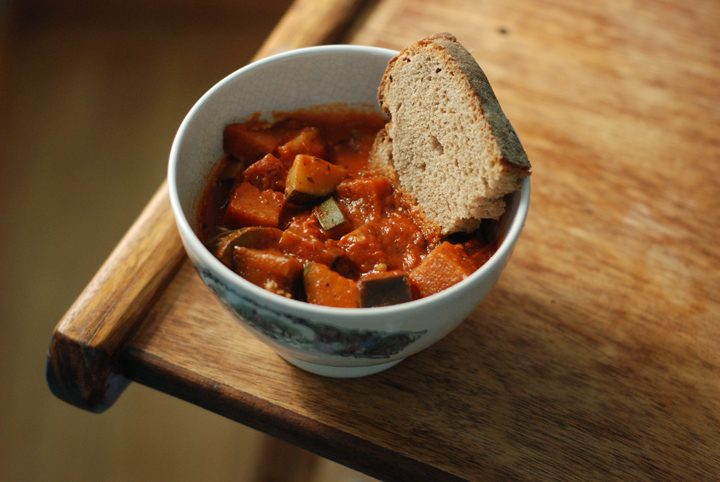

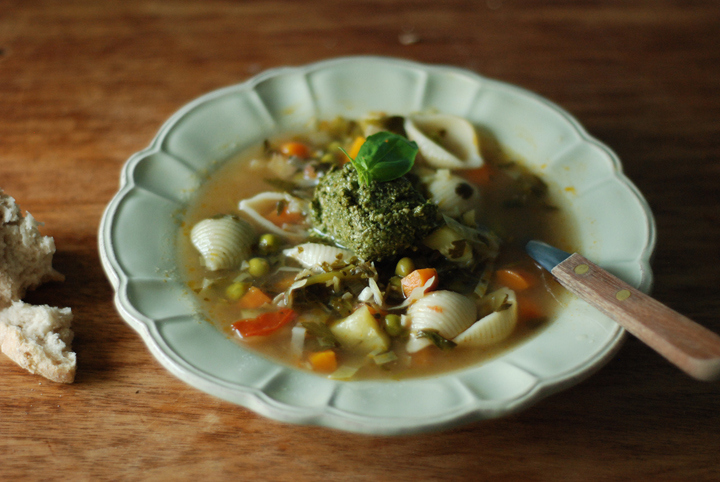
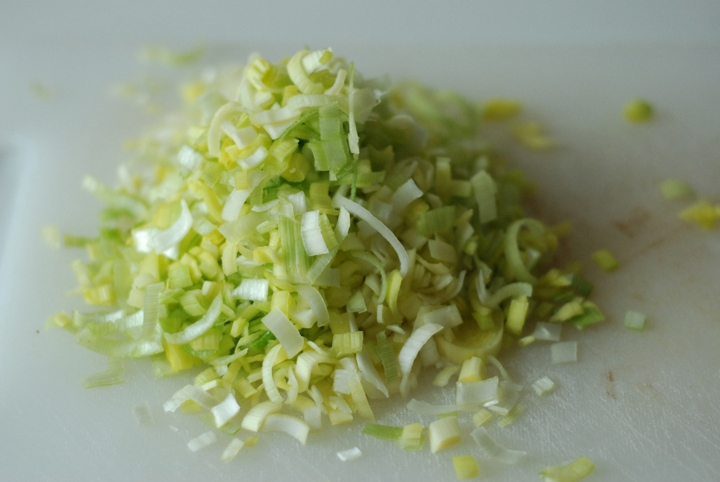
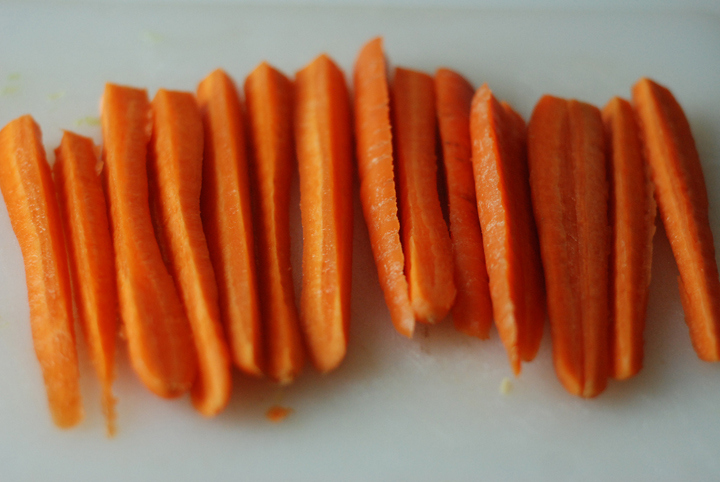

3 comments